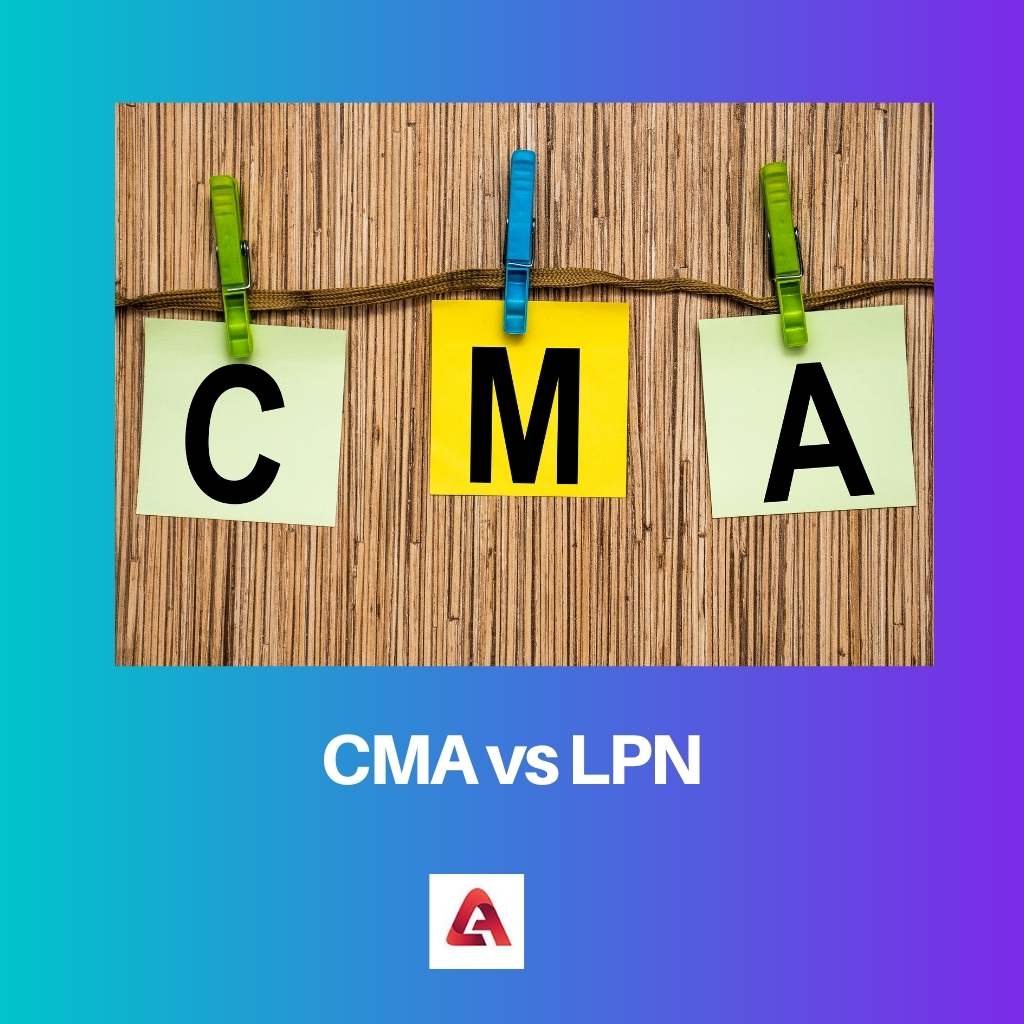Those interested in working in the healthcare field might consider becoming a Certified Medical Assistant (CMA) or a Licensed Nurse Practitioner (LNP) (LPN).
These occupations do not require the same time and money as medical school. CMAs and LPNs, on the other hand, only need a few years of post-secondary schooling.
These professions also allow a professional to undertake a variety of responsibilities that aid in staff communication and the appropriate treatment of patients.
Key Takeaways
- A CMA performs administrative and clinical tasks, while an LPN performs primarily clinical tasks.
- CMAs require certification, while LPNs require licensure.
- CMAs work in various medical settings, while LPNs work in hospitals and long-term care facilities.
CMA vs LPN
A CMA and an LPN degree differ because nursing courses are geared toward inpatient care, whereas master’s courses are geared toward outpatient care. On which programs are the finest, opinions differ. However, if you want to engage in such programs, you must choose a reputable and licensed college.

A certified medical assistant is someone who has received a professional organization’s certification accreditation. They are in charge of providing physician support services to guarantee the smooth operation of medical institutions.
Certified medical assistants can work in a variety of settings, including clerical, administrative, and clinical settings, and they may even be required to undertake more specialized responsibilities.
Licensed Practical Nurses (LPNs) are nurses who assist patients in staying comfortable by doing basic health care duties. Registered Nurses (RNs) and other medical experts supervise them as they work.
The answer to doctors and licensed nurses and they occasionally supervise CNAs. The overall job of a licensed practical nurse in an organization is to guarantee patient comfort and safety.
Comparison Table
| Parameters of Comparison | CMA | LPN |
|---|---|---|
| Working hours | More flexible hours of working. | Less flexible working hours compared to CMA. |
| Responsibilities | Various medical specializations. | Long-term care. |
| License | License is given for the particular field one wishes to work. | Have a proper License. |
| Degree requirement | Degree certified by the CAAHEP or the ABHES. | Finish a nursing curriculum authorized by their state nursing board. |
| Certification | Through the American Association of Medical Assistants | Variety of organizations offer certifications. |
What is CMA?
According to the definition, a Certified Medical Assistant (CMA) is a medical assistant who has completed and passed the American Medical Assistants Association’s accreditation standards (AAMA).
In most situations, you can only get this certificate after completing a medical program that has been approved by the Ministry of Education or the Council for Higher Education Accreditation (CHEA).
Medical assistant responsibilities vary widely based on the needs of the medical facility and the expertise of the ruling healthcare practitioner.
A medical assistant, for example, may only do basic administrative tasks, including appointment scheduling, billing, medical records, and rudimentary laboratory services in some circumstances.
In other medical offices, the medical assistant may be asked to assist with patient care and clinical tasks such as drawing blood, taking and recording vital signs, electrocardiograms,
and assisting the physician during routine exams and appointments.
In reality, most medical assistants will be assigned a mix of clinical and administrative duties by their employers.
Certified medical assistants work a 40-hour workweek, while some work part-time, nights, or weekends.
The day-to-day work varies depending on the healthcare institution and job description. Recertification is required regularly to keep the CMA credentials valid.
Certified Medical Assistants can either retake the certification test or acquire 60 continuing education units (CEUs) or hours of academic or other formal credit to complete the recertification criteria.

What is LPN?
A Licensed Practical Nurse (LPN) is a nurse who is responsible for delivering essential care to patients. This involves assisting them with eating, dressing, bathing, and other activities.
They support Registered Nurses (RNs) and Doctors in maintaining thorough records, ensuring clear communication among the entire care team,
and educating patients and their families about procedures and how to care for sick relatives.
A recognized practical nursing certificate program, which is commonly provided at community colleges and takes about a year to finish, is required to become an LPN.
Students may anticipate taking biology, pharmacology, and nursing courses in addition to clinical experiences.
And Individuals will earn a certificate after completing their practical nursing degree, but they must pass the National Licensure Examination (NCLEX-PN) to become formally licensed and begin their profession.
One also requires excellent organizational abilities as an LPN. Nursing is a tough, fast-paced profession in which your ability to handle information and multi-task is critical to people’s health and well-being.
If you don’t have an organized system in place, it’s easy to become frazzled and make basic mistakes.
Most essential, one must be able to tolerate blood, bodily fluids, and all of the other things you will see, touch, and smell when working with the human body.
Not everyone is capable of dealing with these difficulties, so it’s crucial to be conscious of one’s limitations.

Main Differences Between a CMA and an LPN
- When compared to Licensed Practical Nurses, Medical Assistants, or MAs, have greater flexibility in their working hours (LPNs).
- LPNs are primarily focused on long-term care, such as in a hospital environment, but MAs can work in a range of medical disciplines.
- MAs, unlike LPNs, do not have licenses. As a result, individuals are unable to engage in the more complex aspects of some medical treatments.
- To be eligible for certification, aspiring CMAs need to receive a degree certified by the Commission on Accreditation of Allied Health Education Programs (CAAHEP) or the Accrediting Bureau of Health Education Schools (ABHES) and on the other hand, to be eligible for state licensing, LPNs must finish a nursing curriculum that their state nursing board has authorized.
- The American Association of Medical Assistants (AAMA) offers CMA certification (AAMA) whereas a variety of organizations, including the National Association for Practical Nurse Education and Service (NAPNES), the National Federation of Licensed Practical Nurses (NFLPN), and others, offer certification to LPNs.

- https://europepmc.org/article/med/30369144
- https://assets.nursingald.com/uploads/publication/pdf/2170/New_Jersey_Nurse_1_21_digital.pdf#page=8

The information provided about CMAs and LPNs, along with the specific details about the degree requirements, certification process, and responsibilities, is extremely valuable for individuals considering a career in the healthcare field.
Agreed, the comparison and detailed definitions provided in this article are very enlightening.
The detailed breakdown of the responsibilities and requirements for CMAs and LPNs has provided valuable insights into the career opportunities offered in the healthcare field.
The content of this post clearly highlights the significance of the roles of Certified Medical Assistants and Licensed Practical Nurses in the healthcare sector.
The table comparing the working hours, responsibilities, license, degree requirement, and certification for CMA and LPN is very helpful in understanding the key differences between the roles.
The explanation of the key differences between CMAs and LPNs has helped in understanding the unique aspects of each role and the educational pathways to pursue them.
The in-depth discussion and comparison of CMA and LPN roles have elucidated the distinctive characteristics and qualifications associated with each career option, making it easier for individuals to consider their suitability.
Pursuing a career as a Certified Medical Assistant or Licensed Nurse Practitioner is an excellent option considering the relatively few years of post-secondary schooling required and the diverse range of responsibilities associated with each role.
Yes, the detailed comparison between CMAs and LPNs is quite insightful.
I agree, this is a great article for anyone interested in the healthcare field.
The explanation of the role and responsibilities of a Certified Medical Assistant and a Licensed Practical Nurse is quite comprehensive, making it easier to understand the scope of each profession.